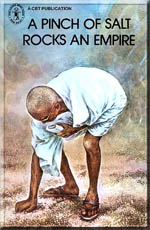
P.O. SEVAGRAM, DIST.WARDHA 442102, MS, INDIA. Phone: 91-7152-284753
FOUNDED BY MAHATMA GANDHI IN 1936
A Pinch of Salt Rocks An Empire
Children's Book : on Dandi March - Salt March

A PINCH OF SALT ROCKS AN EMPIRE
Compiled & Edited by : Sarojini Sinha
Table of Contents
- Map of March Route
- Chapter-1
- Chapter-2
- Chapter-3
- Chapter-4
- Chapter-5
- Chapter-6
- Chapter-7
- Chapter-8
- Chapter-9
- Chapter-10
- Chapter-11
- Chapter-12
- Chapter-13
About This Book
Compiled & Edited by : Sarojini Sinha
Illustration by : : Mrinal Mitra
First Published :1985
I.S.B.N :81-7011-291-5
Published by :Children's Book Trust
Printed at : Indraprastha Press
Nehru House,
4 Bahadur Shah Zafar Marg,
New Delhi,
India
Navajivan Mudranalaya,
Ahemadabad-380014
India.
© CBT, 1985
Download
Chapter - 7
On the morning of April 6, 1930, as Gandhiji walked down the steps of the bungalow, he was greeted by about four thousand people who had been gathering all night.
Gandhiji swam for a while in the sea and came out when his companions told him that it was nearly time for the start of the satyagraha. Gandhiji bent down and scooped up a handful of salt.
Gandhiji's face was calm as he held out his fist to the crowd and opened it to show the white crystals. It was the newest symbol in the struggle for India's freedom.
Shortly afterwards the satyagrahis went to a creek nearby where the salt deposits were thicker than on the beach. At another creek fifty-six volunteers from a neighbouring village collected salt, piled it up and carried it away in bags.
The whole operation was done in an orderly manner with a leader giving sharp blasts on a whistle to mark each stage. It looked as if the group had been drilled for a long time.
About five hundred kilos of salt was collected that morning. Late in the afternoon, the police seized the salt. But as soon as the police left, the villagers again collected salt and distributed it in the village.
The Salt Act had been broken. The signal had been given for Indians to act. In a press statement Gandhiji urged people everywhere to violate the salt law. Those who knew how to clean and prepare salt should show others how to do it.
But the villagers should be clearly told that, in making salt, they ran the risk
of arrest, fine and imprisonment. The law had to be broken openly.
The attack on the Salt Act was to continue throughout National Week. Also, people were asked to boycott foreign cloth, produce and use khadi and give up drinking liquor.
The country was flooded with pamphlets explaining how to make salt from sea water. And all along India's long coastline, villagers waded into the sea with pans.
Inland also people made salt. There were mass meetings, fiery speeches and large processions. From one end of India to the other bonfires of British cloth were lighted. Liquor shops were picketed. Some government servants resigned.
In Gujarat, the civil disobedience movement spread fast. The government arrested the leaders, but new leaders came forward to take their places.
Gandhiji congratulated those who were arrested. "Imprisonment and the like are a test which the civil resistor has to pass", he said.
He told the people, "The honour of India has been symbolized by a fistful of salt in the hand of a man of non-violence. The fist which held the salt may be broken, but it will not yield up its salt.
"Salt in the hands of satyagrahis represents the honour of the nation. It cannot be yielded up, except to force that will break the hand to pieces. Let the people defend the salt in their possession till they break in the attempt, but they should do so without anger."
Addressing a women's conference at Dandi on April 13 he said that women should join the national movement.
How well Gandhiji's instructions were understood was evident when police raided Congress House in Bombay. They rushed upstairs and began breaking the thirty-two salt pans that had been placed on the roof. During the two hours it took them to finish that operation a crowd of sixty thousand gathered round the building and on the roads leading to it.
When the policemen came down and tried to enter the office, they found six women blocking their way. Their leader said, "You may arrest us or do what you like, but we will not desert our post of duty."
The police lost patience and pushed the women aside, while the crowd outside sang national songs. They then turned their attention to the salt pans downstairs, but a party of a hundred volunteers had formed a circle round the pans and the cordon could be broken only after repeated charges. The volunteers suffered the attacks cheerfully and made no attempt to harm the policemen or even try to push them back. And the crowd outside remained peaceful.
It was a remarkable demonstration of non-violent agitation and an example that must have gladdened Gandhiji's heart. The crowd could easily have over-powered the few policemen, but it desisted. On seeing the volunteers' patience, courage and patriotism, several people enrolled themselves to offer satyagraha.
As the movement spread, salt illegally made or collected was openly sold in the streets of cities. In Ahmedabad, contraband worth Rs 11,000, all of it made in the first week of the satyagraha, was sold or distributed. The salt picked up by Gandhiji at Dandi was of such poor quality that it could hardly be used, but it had symbolic value. When auctioned, it fetched Rs 1,600.
